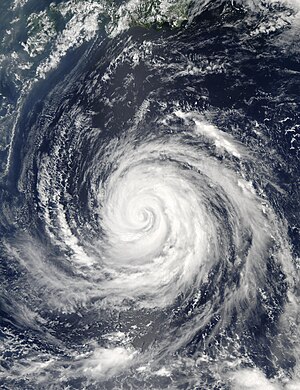Typhoon Rusa
Hitting on August 22, 2002, Typhoon Rusa was the most powerful typhoon to strike South Korea in 43 years. It was the 21st Joint Typhoon Warning Center tropical depression, the 15th named storm, and the 10th typhoon of the 2002 Pacific typhoon season. It started on August 22 from the monsoon trough in the northwestern Pacific Ocean, well to the southeast of Japan. For several days, Rusa moved to the northwest, eventually growing into a powerful typhoon. On August 26, the storm moved across the Amami Islands of Japan, where Rusa left 20,000 people without power and caused two deaths. Across Japan, the typhoon dropped torrential rainfall peaking at 902 mm (35.5 in) in Tokushima Prefecture.

After weakening a little bit, Rusa made landfall on Goheung, South Korea with winds of 140 km/h (85 mph 10 minute sustained). Rusa weakened while moving through the country, dropping heavy rainfall that peaked at 897.5 mm (35.33 in) in Gangneung. A 24-hour total of 880 mm (35 in) in the city broke the record for the highest daily precipitation in the country; however, the heaviest rainfall was local. Over 17,000 houses were damaged, and large areas of crop fields were flooded. In South Korea, Rusa killed at least 233 people, making it the deadliest typhoon there in over 43 years, and caused $4.2 billion in damage. The typhoon also dropped heavy rainfall in neighbouring North Korea, leaving 26,000 people homeless and killing three. Rusa also destroyed large areas of crops in the country already affected by ongoing famine conditions. The typhoon later became extratropical over eastern Russia on September 1, dissipating three days later.